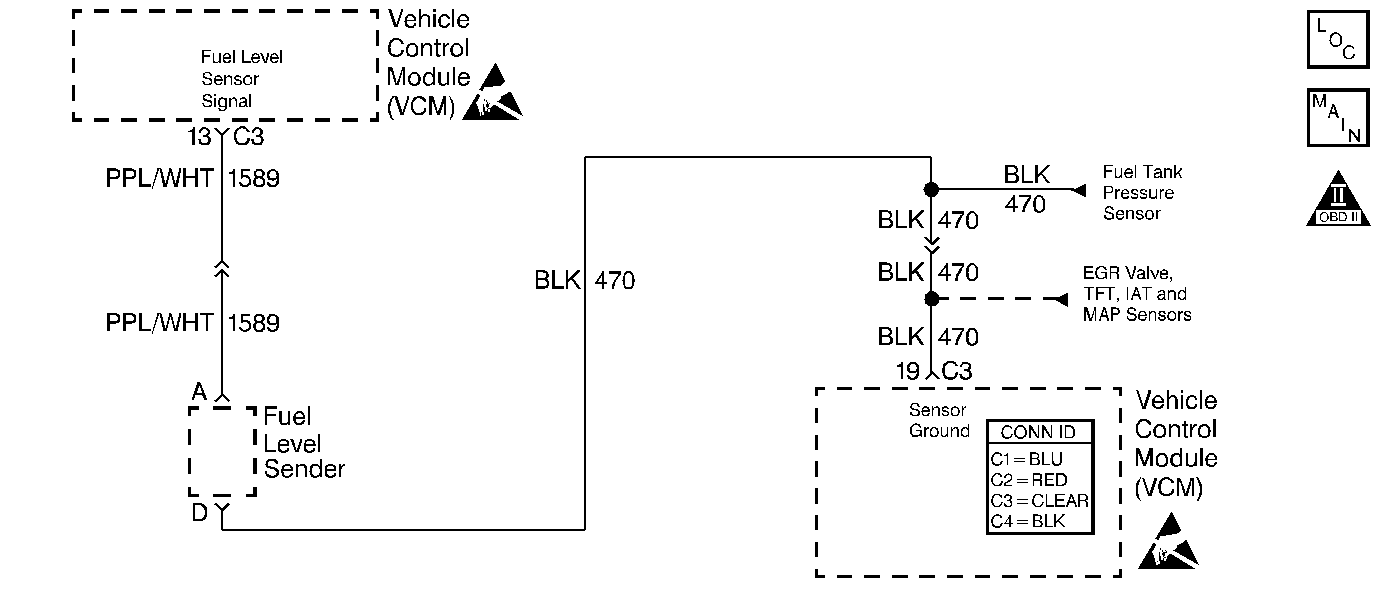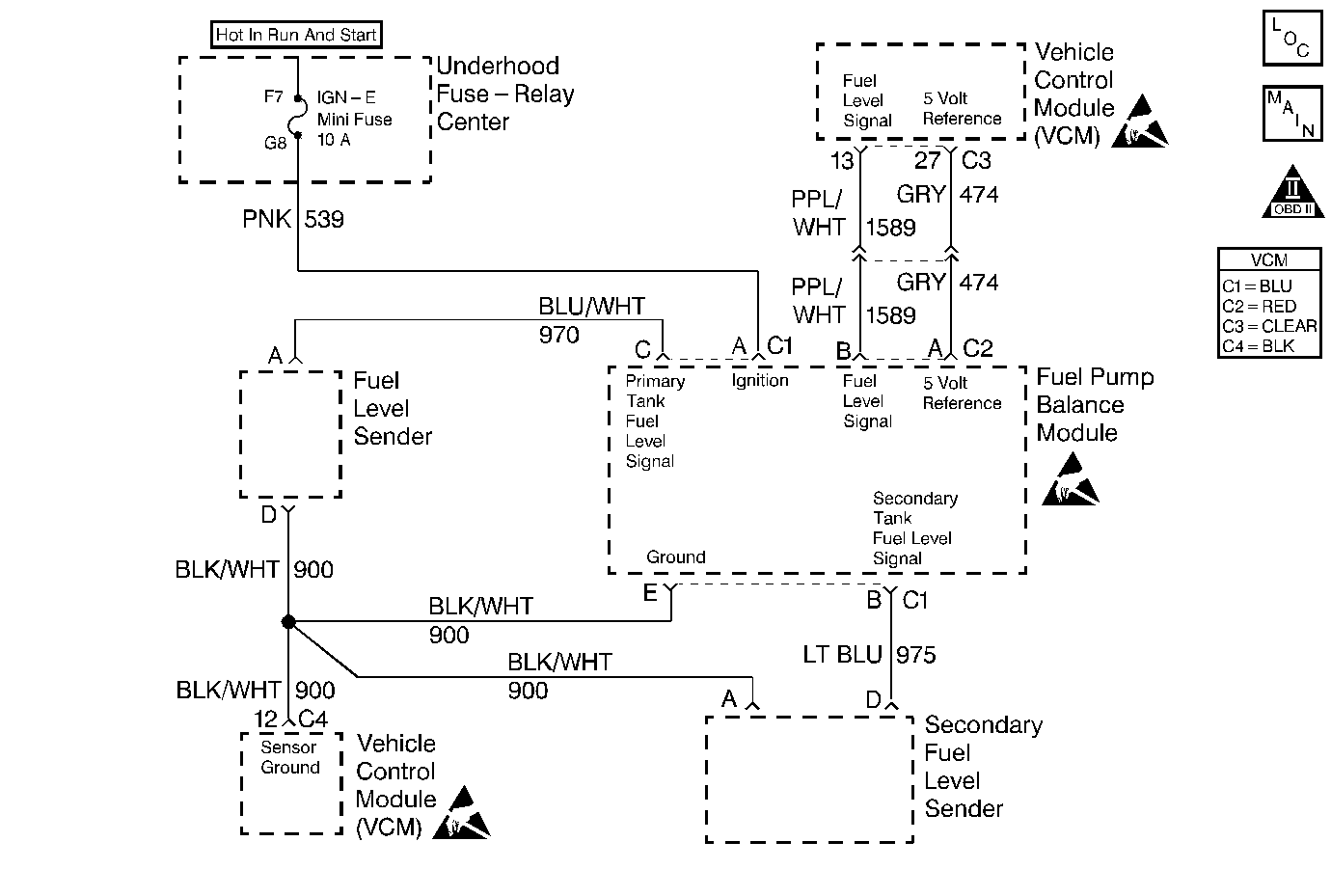DTC P0462 Fuel Level Sensor Circuit Low Voltage Single Tank

Circuit Description
The VCM requires an accurate indication of fuel level for EVAP system diagnosis. The fuel level in the fuel tank changes the rate of vacuum decay for the EVAP system leak DTCs.
The Fuel Level Sensor changes resistance based on fuel level. The Fuel Level Sensor has a signal circuit and a ground circuit. The VCM applies a voltage (about 5 volts) on the signal circuit to the sensor. The VCM monitors changes in this voltage caused by changes in the resistance of the sensor to determine fuel level.
When the fuel tank is full, the sensor resistance is high, and the VCMs signal voltage is only pulled down a small amount through the sensor to ground. Therefore, the VCM will sense a high signal voltage (fuel tank full). When the fuel tank is empty, the sensor resistance is low, and the signal voltage is pulled down a greater amount. This causes the VCM to sense a low signal voltage (fuel tank empty).
The VCM uses the input from the Fuel Level Sensor to calculate the fuel level in the fuel tank. This information is then sent to the IPC through Serial Data.
The diagnostic will not run when the tank is more than 85 percent or less than 15 percent full. (This sensor signal disables the misfire when the fuel levels are less than 15 percent).
Conditions for Running the DTC
The ignition switch is in the RUN position.
Conditions for Setting the DTC
The fuel level sensor voltage remains below 0.39 volts for more than 20 seconds
Action Taken When the DTC Sets
| • | The control module stores the DTC in history after the first failure but will not illuminate the malfunction indicator lamp (MIL). |
| • | The control module records the operating conditions at the time the diagnostic fails. The control module stores the failure information in the scan tools Freeze Frame/Failure Records. |
Conditions for Clearing the MIL/DTC
| • | A history DTC will clear if no fault conditions have been detected for 40 warm-up cycles. |
| • | A warm-up cycle occurs when the coolant temperature has risen 22°C (40°F) from the startup coolant temperature and the engine coolant temperature exceeds 70°C (160°F) during the same ignition cycle. |
| • | Use the scan tool Clear Information function. |
Diagnostic Aids
Important: Fuel level is used to determine EVAP system diagnosis. Always diagnose the fuel level sensor before any other EVAP system components or DTCs.
Do not use the fuel gauge as an indication of a shorted or open circuit as the IPC may always default to EMPTY or FULL depending upon vehicle model.Check for the following conditions:
| • | A poor connection or damaged harness - Inspect VCM harness connectors for the following: |
| - | Backed out terminals |
| - | Improper mating |
| - | Broken locks |
| - | Poor wire to terminal connections |
| • | Intermittent test - monitor a scan tool or digital voltmeter connected between the related circuits while moving the connectors and harnesses. If the failure is induced, the voltage reading will change. This will help locate a circuit problem. |
Test Description
The numbers below refer to the step numbers in the diagnostic table.
Step | Action | Value(s) | Yes | No |
|---|---|---|---|---|
1 |
Important: : Before clearing the DTCs, use the scan tool Capture Info to save the Freeze Frame and Failure Records for reference. The control module's data is deleted once the Clear Info function is used. Did you perform the Powertrain On-Board Diagnostic (OBD) System Check? | -- | ||
2 |
Is the voltage less than the specified value? | 0.39V | ||
3 | This DTC is intermittent. Are any additional DTCs stored? | -- | Go to applicable DTC table | Go to Diagnostic Aids |
Is the fuel tank level sensor voltage near the specified value? | 5V | |||
5 | Check for a short to ground in the fuel level signal circuit. Was a problem found? | -- | ||
6 | Check the electrical connections at the Fuel Level Sender for corrosion or a short to ground. Was a problem found? | -- | ||
7 | Repair the circuit as necessary. Refer to Wiring Repairs in Wiring Systems. Is the action complete? | -- | -- | |
8 | Replace the Fuel Level Sensor. Refer to Fuel Level Sensor Replacement . Is action complete? | -- | -- | |
9 |
Is the action complete? | -- | -- | |
10 |
Does the scan tool indicate the diagnostic Passed? | -- | ||
11 | Does the scan tool display any additional undiagnosed DTCs? | -- | Go to the applicable DTC table | System OK |
DTC P0462 Fuel Level Sensor Circuit Low Voltage Dual Tanks

Circuit Description
The Fuel Level sensor is an important input to the VCM for the Enhanced Evaporative System Diagnostic. The VCM needs the fuel level information in order to know the volume of fuel in the tank. The fuel level affects the rate of change in the air pressure in the EVAP system. Several of the Enhanced Evaporative System Diagnostic sub-test are dependent upon the correct fuel level information. The diagnostic will not run when the tank is more than 85% or less than 15% full. (This sensor signal disables the misfire when the fuel levels are less than 15%).
Conditions for Setting the DTC
| • | The fuel tank slosh test is completed |
| • | The fuel tank main level test is completed |
| • | The fuel tank level data is valid |
| • | The fuel level signal voltage is less than 0.39 volts for a period greater than 20 seconds |
Action Taken When the DTC Sets
| • | The control module stores the DTC in history after the first failure but will not illuminate the malfunction indicator lamp (MIL). |
| • | The control module records the operating conditions at the time the diagnostic fails. The control module stores the failure information in the scan tools Freeze Frame/Failure Records. |
Conditions for Clearing the MIL or DTC
| • | The control module turns OFF the MIL after 3 consecutive drive trips when the test has run and passed. |
| • | A history DTC will clear if no fault conditions have been detected for 40 warm-up cycles. A warm-up cycle occurs when the coolant temperature has risen 22°C (40°F) from the startup coolant temperature and the engine coolant reaches a temperature that is more than 70°C (158°F) during the same ignition cycle. |
| • | Use a scan tool in order to clear the DTCs. |
Diagnostic Aids
Check for the following conditions:
| • | A poor connection or damaged harness - Inspect VCM harness connectors for the following: |
| - | Backed out terminals |
| - | Improper mating |
| - | Broken locks |
| - | Poor wire to terminal connections |
| • | Intermittent test - monitor a scan tool or digital voltmeter connected between the related circuits while moving the connectors and harnesses. If the failure is induced, the voltage reading will change. This wil help locate a circuit problem. |
Test Description
The numbers below refer to the step numbers in the diagnostic table.
Step | Action | Value(s) | Yes | No |
|---|---|---|---|---|
1 |
Important: Before clearing the DTCs, use the scan tool in order to record the Freeze Frame and the Failure Records for reference. This data will be lost when the Clear Info function is used. Was the On-Board Diagnostic (OBD) System Check performed? | -- | ||
2 |
Is the voltage less than the specified value? | 0.39V | ||
3 | This DTC is intermittent. Are any additional DTCs stored? | -- | Go to applicable DTC table | Go to Diagnostic Aids |
Is the voltage above the specified value? | 4.5V | |||
5 |
Is the voltage above the specified value? | 4.5V | ||
6 | Check the fuel level input circuit for an open or a short to ground. Did you find a problem? | -- | ||
7 | The following procedure must be done with the fuel tanks full.
Is the measured resistance between the specified value? | 30-260 ohms | ||
8 | Measure the resistance of the auxiliary fuel tank sender between the signal circuit terminal at the harness connector and ground. Is the resistance between the specified value? | 30-260 ohms | ||
9 | Replace the fuel pump balance module. Is the action complete? | -- | -- | |
10 |
Does the test lamp illuminate? | -- | ||
11 | Check the signal circuit of the sender between the sender and the balance module for an open or a short to ground. Did you find a problem? | -- | ||
12 | Check for good terminal contacts at the fuel pump balance module and the VCM. Did you find a problem? | -- | ||
13 | Replace the fuel level sensor. Refer to Fuel Sender Assembly Replacement . | -- | -- | |
14 | Check for good terminal contacts. Did you find a problem? | -- | ||
15 |
Is the action complete? | -- | -- | |
16 | Are any other DTCs set that share this 5 volt reference circuit? | -- | Diagnose those DTCs first | |
17 | Repair the circuit as necessary. Refer to Wiring Repairs in Wiring Systems. Is the action complete? | -- | -- | |
18 |
Does the scan tool indicate that this diagnostic ran and passed? | -- | ||
19 | Use the scan tool in order to display the Capture Info and the Review Info. Are there any DTCs displayed that have not been diagnosed? | -- | Go to the applicable DTC table | System OK |
